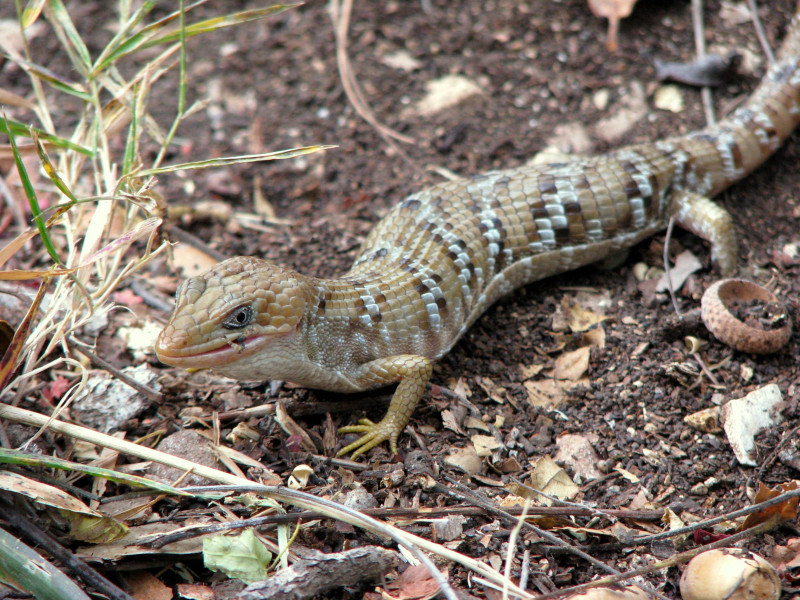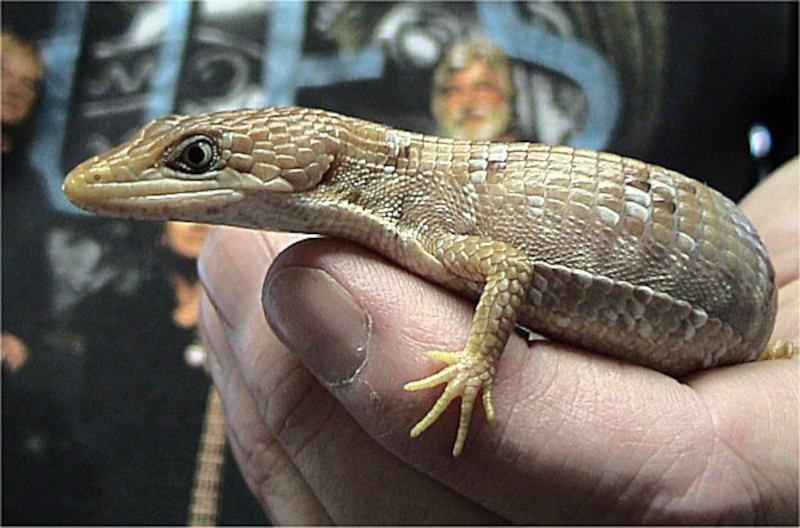
Texas Alligator Lizard Facts
- This intriguing product of reptilian evolution most frequently goes by the attention-grabbing common name of Texas Alligator Lizard. For the moment, this remarkable animal has no other broadly accepted general title, despite its popularity.
- Within the scientific world, however, the animal is perhaps better known by its technical appellation. Unfortunately, like many such terms, that’s a difficult one for the layperson to pronounce. That’s because it holds the official tag Gerrhonotus infernalis.
- The creature received that moniker due to the efforts of Spencer Fullerton Baird. The respected American herpetologist accomplished the first recognition of it as a separate and distinct species. He further managed that notable deed in the year 1859.
- This marvelous work of Nature stands out from its many relatives in at least one respect. That’s true since it ranks as one of the largest of all known reptiles collectively called alligator lizards. It’s also the largest lizard in the region of the world it lives in.
- Thankfully, the Texas Alligator Lizard appears to be maintaining a thriving and abundant population base. That pleasant trend also seems to extend throughout its entire range. The IUCN thus presently lists it as Least Concern on its famous Red List.
- The amazing creature nevertheless should be considered as facing several potential threats to its continued existence as a species, at least. That’s a state it shares with all life on earth, though. These include the perils of habitat loss and climate change.
Related Articles

Texas Alligator Lizard Physical Description
The fascinating Texas Alligator Lizard generally appeals to most of those fortunate enough to encounter it. The animal typically does so, however, due more to its appearance than pure size. That’s true since, though large for its specific kind, it’s an average-sized lizard.
It follows a pattern of evolution common to most animals, including lizards. That’s in the fact that it shows a certain degree of the physiological characteristic of sexual dimorphism. In the case of this particular species, though, that trait manifests in terms of sheer size.
More specifically, the males attain greater overall body measurements than the female of the species. However, that difference remains slight. Distinguishing the genders of individuals based purely on outward appearance can be difficult for untrained observers.
Taken collectively, specimens of this reptile achieve a mean body length roughly ranging from 16 – 18 in (41 – 46 cm). The thin, elongated tail, though, adds an additional average of 8 – 9 in (20 – 23 cm). The tail thus gives it a total mean length of about 24 – 25 in (61 – 64 cm).
In coloring, both sexes of the Texas Alligator Lizard display the same basic pattern. This primarily consists of a background of yellowish-brown. Yet, the upper back often shows a darker brown, with an off-white checkered pattern. The stomach appears gray or white.
One other feature, however, catches the eye, and earns it part of its common name. That’s the presence of stiff, plate-like scales covering much of the body. The legs, meanwhile, develop as relatively short, and its tail can be lost, but regrow over a short span of time.
- Kingdom: Animalia
- Phylum: Chordata
- Class: Reptilia
- Order: Squamata
- Family: Anguidae
- Genus: Gerrhonotus
- Species: G. infernalis
Texas Alligator Lizard Distribution, Habitat, and Ecology
The impressive Texas Alligator Lizard apparently evolved as native to only a small swathe of the earth’s surface. But, the exact location of this zone of habitation won’t come as a surprise to anyone. That’s true since, as the name implies, it’s mainly present in Texas.
This member of the United States, appears in the approximate south-central portion of the country. Within that area, though, this animal only lives in the central and southern sections. It also lives in small portions of the northern regions of the country of Mexico.
Inside of that territorial range, the lizard displays a moderate amount of flexibility regarding its choice of habitat. It thus resides in several different types of local ecosystems. Yet, in all of the areas it makes its home, it generally lives in either arid or semi-arid regions.
Most frequently, the reptile lives in regions of rocky hillsides and slopes, because these provide ample cover. It does dwell in other locations, though. Some of these include such places as inside rocky canyons, and close to comparatively rocky springs or streams.
The aptly-named Texas Alligator Lizard developed as carnivorous in nature, as well as diurnal. Generally, it consumes smaller sources of nutrition, including insects and other, similar-sized invertebrates. But, it occasionally feeds on small rodents, or even nesting birds.
When not actively hunting its prey, the animal generally spends its time hiding in the shade. Breeding takes place throughout the year, with several clutches being laid. Females typically remain close to the nest until after hatching occurs, but ignore them thereafter.
Species Sharing Its Range
Check out our other articles on 5 Beautiful Black Sea Species, Ribbon Seal, Kings Canyon, Fire Salamander, Lime Butterfly, Spiny Butterfly Ray, Coral Honeysuckle, Nicobar Pigeon, Maned Wolf
